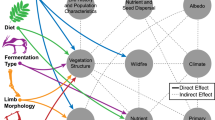Abstract
Ecological segregation (sexual differences in diet or habitat use) in large herbivores has been intimately linked to sexual body size dimorphism, and may affect both performance and survival of the sexes. However, no one has tested comparatively whether segregation occurs at a higher frequency among more dimorphic species. To test this comparatively, data on sex-specific diet, habitat use and body size of 40 species of large herbivores were extracted from the literature. The frequency of ecological segregation was higher among more dimorphic herbivores; however, this was only significant for browsers. This provides the first evidence that segregation is more common among more dimorphic species. The comparative evidence supported the nutritional-needs hypothesis over the incisor breadth hypothesis, as there was no difference in frequency of segregation between seasons with high and low resource levels, and since segregation was also evident among browsers. Whether the absence of a correlation between ecological segregation and level of sexual body size dimorphism for intermediate feeders and grazers is due to biological differences relative to browsers or to the fact that the monomorphic species included in the analysis were all browsers is discussed.
Similar content being viewed by others
Author information
Authors and Affiliations
Additional information
Received: 18 August 1999 / Accepted: 31 January 2000
Rights and permissions
About this article
Cite this article
Mysterud, A. The relationship between ecological segregation and sexual body size dimorphism in large herbivores. Oecologia 124, 40–54 (2000). https://doi.org/10.1007/s004420050023
Issue Date:
DOI: https://doi.org/10.1007/s004420050023




